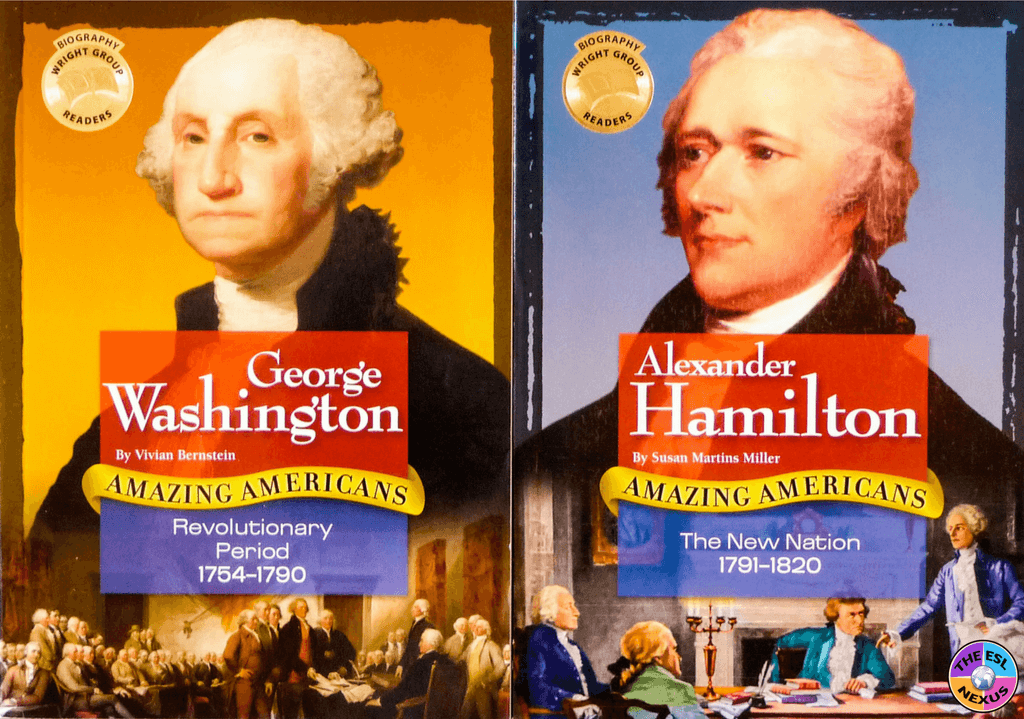(This post contains affiliate links. That means that I make a small commission if you make a purchase but it's at no additional cost to you. Thank you for your support!)
 |
| Read on for resources for teaching ELLs about the War for Independence; graphic created by: The ESL Nexus |
PRIMARY SOURCES AT THE NATIONAL ARCHIVES
America’s Founding Documents
* The Declaration of Independence* The Constitution of the United States
* The Bill of Rights
TEXTBOOKS
 |
| 2 textbooks I used with my students: graphic created by: The ESL Nexus |
I used the 2nd edition, which was paperback; now there is a newer hardcover version. I really liked this book because it used the CALLA approach -- the student tasks mixed language learning with strategies for how to learn academic content. There is a separate teacher’s book which I didn’t use much because it was pretty easy to figure out how to use the student book. The hardcover book is expensive so unless you’re desperate, I’d ask your school to buy it instead of paying out of pocket yourself.
* Content Area ESL: Social Studies by Dennis Terdy
Two chapters, called The War for Independence and A Nation Begins, use simplified language and describe in very general terms what the war was about and its aftermath. There are a lot of language-focused exercises so this is a good choice for ELLs at low intermediate levels of proficiency.
BOOKS ABOUT THE REVOLUTIONARY WAR
* Road to Revolution by Francis Downey; National Geographic School PublishingA 26-page book with text that intermediate proficiency level ELLs should be able to comprehend; includes 4 pages of activities at the end plus a 2-page glossary (words are also glossed in the text itself). As can be expected with a National Geographic publication, there are loads of pictures; in fact, the content is about half text and half images. Good for independent reading and doing research.
* The American Revolution by Cindy Barden
Lots of short reading passages with comprehension questions and some activities. Also includes a timeline from 1733 – 1783 detailing causes and events of the war up to the signing of the Treaty of Paris. Good for activities to supplement your teaching.
* American Revolution by Dorling Kindersley/Eyewitness Books
If you’re familiar with these books, you’ll know that they are great reference sources. Tons of full color pictures with paragraph-long captions, along with more detailed paragraphs about various topics related to the Revolutionary War. For high intermediate proficiency level ELLs, this book can be used to keep early finishers occupied and can also be used when doing research.
BIOGRAPHIES OF FAMOUS PEOPLE
 |
| These little books are great for research & independent reading; graphic created by: The ESL Nexus |
* McGraw Hill / The Wright Group also published a series of biographies called Amazing Americans. I have the ones about George Washington and Alexander Hamilton. These are longer (32 pages) and at a higher proficiency level (intermediate and up) but also have lots of full color pictures. Use these books in the same ways as above.
 |
| More books that ELLs can read on their own; graphic created by: The ESL Nexus |
* Rosen Classroom / PrimarySource also publishes biographies. I have 3 in their series: 2 about Paul Revere (one is focused on his Midnight Ride and the other is more general) and another about George Washington crossing the Delaware River. These books are at an intermediate level, are all 32 pages long, and include full color illustrations and photos. They are also good for independent reading and creating presentations.
 |
| Even more books for independent reading or research; graphic created by: The ESL Nexus |
BOOKS ABOUT THE CONSTITUTION AND THE THREE BRANCHES OF GOVERNMENT
 |
| Having lots of resources on these topics is always a good idea; graphic created by: The ESL Nexus |
Lots of activities to supplement your teaching. ELLs will need to be at an intermediate level of language proficiency or higher in order to do them.
* American Government Today series by Steadwell Books/Steck-Vaughan
A book series with titles on The Presidency, Congress, The Supreme Court, and Your Right to Vote. (Also includes Washington, D.C., and The White House but I don’t have those.) Other than the book about the presidency, these may be hard to find but if you can, they offer clear explanations about the branches of government. For high intermediate proficiency and up. Each book is only 48 pages and has lots of pictures. Useful for doing jigsaw reading and doing research. You might also consider reading portions aloud and discussing them with your students.
* Barron’s series by Syl Sobel
This links to the first book listed below but links to the others are on the webpage. I have 3 of the books in this series, which is at a high intermediate proficiency level: The Declaration of Independence, The U.S. Constitution and You, and The Bill of Rights. Also included are How the U.S. Government Works, Presidential Elections but I don't have these two. Lots of drawings, though not in color; again, these books are good for jigsaw reading, doing research, and read alouds.
OTHER MATERIALS
* Liberty’s KidsThis is a wonderful animated TV show that ran on PBS years ago. In the episodes I videotaped, there are segments comparing life in the Colonial period with modern life, a newscast that summarized the main ideas of the episode, and a game; these segments are not included in the videos that you can find online for free. There are 40 episodes in all but I didn’t show all of them. My 5th graders loved watching this show!
* Origins of the song Yankee Doodle
This article from The New York Times gives some interesting background information about the song.
MY OTHER JULY 4TH BLOG POSTS
I wrote 2 previous 4th of July posts; you can read them HERE.
Happy Fourth of July!
